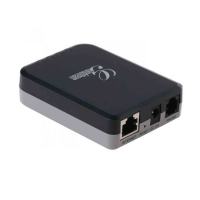HT70X User manual
Version 1.0.9.4
Default is 20ms. Sets the iLBC frame size in 20ms or 30ms.
Defines payload type for iLBC. Default value is 97. The valid range is between
96 and 127.
Default is No. VAD allows detecting the absence of audio and conserve
bandwidth by preventing the transmission of "silent packets" over the network.
Default is No. When set to Yes the device will change the destination to send
RTP packets to the source IP address and port of the inbound RTP packet last
received by the device.
T.38 (Auto Detect) FoIP by default, or Pass-Through (must use codec
PCMU/PCMA)
Default is Caller. This option is used to configure the mode how the device
detect the fax tone, it can be the mode of caller, callee and caller or callee.
Re-Invite after Fax
Tone Detection Mode
Default is Enabled. It makes the unit send out the re-INVITE for T.38 or Fax
Pass Through if a fax tone is detected.
Select either Fixed or Adaptive based on network conditions. Default is
Adaptive.
Select Low, Medium or High based on network conditions. Default is Medium.
• High (initial 200ms, min 40ms, max 600ms) Note: not all vocoders can
meet the high requirement
• Medium (initial 100ms, min 20ms, max 200ms)
• Low (initial 50ms, min 10ms, max 100ms)
This option defines different implementation of support SRTP (squired RTP)
transmission mode. Select between Disabled, Enabled but not Forced, and
Enabled and Forced. Default is Disabled.
Default setting is Yes. Enable or disable the crypto life time when using SRTP.
If users set to disable this option, phone does not add the crypto life time to
SRTP header.
Dependent on standard phone type (and location)
Bellcore/Telcordia, ETSI-FSK, ETSI-DTMF, SIN 227 – BT, & NTT Japan, Brazil
Define the Start Tone and Stop Tone.
Default is No.
If set to “Yes”, polarity will be reversed upon call establishment and termination.

